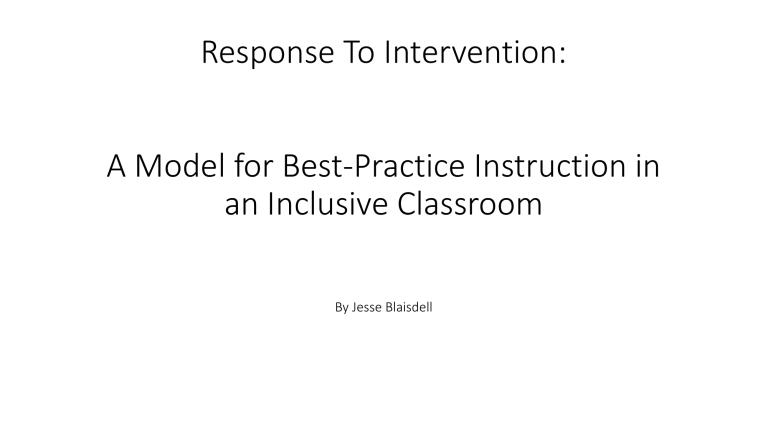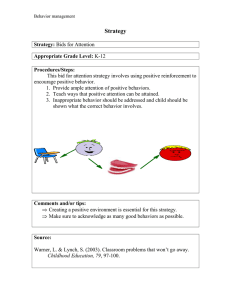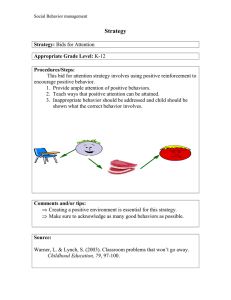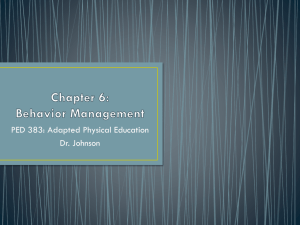
Response To Intervention: A Model for Best-Practice Instruction in an Inclusive Classroom By Jesse Blaisdell Roles of Teachers • Order, Structure, and Consistency • ROUTINES, RULES, CONSEQUENCES, CONSTRUCTIVE FEEEDBACK • Running, Feet on floor, Language, Common Courtesy, Mutual Respect, Etiquette • What Constitutes Bullying? • Realistic Expectations & Clear Instructions • GOALS, RUBRICS, MODELING, ALTERNATIVE FORMATTING, OPTIONS • Choices for Students • VARIETY OF MATERIALS & TOPICS (within reason), TECHNOLOGY, STUDENT COLLABORATION • Able to Interpret Communicative Intent of Students • TEACHER INTUITION, PATIENCE, HONESTY, UNDERSTANDING DISABILTY • Potential Behavioral Challenges with Students with Mild to Moderate Disabilities • FOLLOWING DIRECTIONS • WORK AVOIDANCE • SELF-CONTROL • VERBAL/PHYSICAL AGGRESSION • ANXIETY • PROPERTY DESTRUCTION • IMPULSIVITY • SOCIAL-EMOTIONAL • https://www.frontiersin.org/articles/10.3389/feduc.2019.00159/full • Guidelines for Establishing and Enforcing Classroom Rules and Procedures in a Classroom • SETTING RULES & POSTING RULES • FEW IN NUMBER, CLEARLY DEFINED, LINKEED TO SPECIFIC CONSEQUENCES • GENERAL BEHAVIOR • ASSIGNED SEATING, MUTUAL RESPECT • PROCEDURES • GROUP WORK, BEGINNING/END OF CLASS, PARTICIPATION, TARDINESS/ABSENCE, MAKEUP WORK, ATTENDENCE • TRANSITIONS/INTERUPTIONS • ROUTINES, FIRE DRILLS, LEAVING/RETURNING TO ROOM • USE OF MATERIALS • DISTRIBUTION, COLLECTING, STORING, CREATING, USING ELECTRONIC RESOURCES • Basic Steps for Developing a Functional Behavioral Assessment • A-B-C Analysis •ANTECEDENT, BEHAVIOR, CONSEQUENCE •CONFIRM HYPOTHESIS AND PLAN INTERVENTION •ASSESSEMENT TECHNIQUES TO ANALYZE BEHAVIORS (QUALITATIVE & QUANTITATIVE) • ACADEMIC, SOCIAL, PEER, FAMILY, ETC. • Understanding Patterns = Plan Development •MODIFICATION, TEACHING ALTERNATIVES, REINFORCEMENT, EXTINGUISHING BEHAVIORS Behavioral Intervention Plan (BIP) • Overall Goals to be Achieved • FOLLOWING DIRECTIONS, INTERUPTIONS, ATTENTION-SEEKING • Attention to Planned Activities • Persons Responsible for Implementing • TEACHERS, SPECIALISTS, TECHNICIANS, PARAPROFESSIONALS • Proposed Activities • Timelines to be Followed • Plans for Intervention • CUES, REPETITION, POINTS Benefits of Positive Behavioral Supports • Sets Clear Boundaries and Goals • Observable • Measurable • Avoids Stigmatization and Pain • Conveys Respect for a Person’s Life, Circumstances, Preferences, and Goals • Inclusive • Enhances Quality of Life • Minimizes and Prevents Problem Behaviors Social Interventions for Students Displaying Social Difficulties • "First Step to Success" program • Through Positive Reinforcement and Praise, Students are Encouraged to: • • • • • • Express Feelings Interact with Peers Develop Healthy Relationships Work in Peer Groups Use Humor Develop confidence • Common Techniques in Positive Behavior Support and Intervention Programs • Natural and Logical Consequences • Allows for the situation to teach the child, rather than direct intervention • Common Sence • Differential Reinforcement • Reinforcement based on the omission of a given behavior • Extinction • withholding of reinforcement that previously maintained a specific behavior or behaviors • Can use peers to withold reinforcement Common Techniques in Positive Behavior Support and Intervention Programs • Time out from Positive Reinforcement • • • • Planned Ignoring Contingent Observation (student can see peers, but is removed from activity) Exclusion from the Time-In Environment Seclusion • Response Cost • Student Relinquishes Points or Tokens within Established Positive Reinforcement Program Best Practices for Exceptional Learner Instuctional Development • Inclusivity • Diversity (first language), Universal Design, Students Learn Together, Create a Sense of Community, Collaboration, Peer-Led Activities • Safe, Accessible, and Accommodating • Safety Procedures, UDL Strategies Promotes Conversation, Accepting Atmosphere • Least Restrictive Environment • Flexibility, Maximize Student Strengths, Community Building • RTI Multi-Tier Approach • Inclusion Model, Not waiting for Student to Fail before Intervention, Collaboration, Not Fixed • Natural Proportion • Allows for Easier Interaction between Students, • https://www.youtube.com/watch?v=00sRVmZa_zg References • Polloway, E. A., Patton, J. R., Serna, L., & Bailey, J. W. (2018). Strategies for teaching learners with special needs (11th ed.). Upper Saddle River, NJ: Pearson. • https://www.frontiersin.org/articles/10.3389/feduc.2019.00159/full • https://www.youtube.com/watch?v=fWkMVmW2VX0







